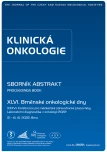Sequencing of long non-coding RNAs in exosomes of colorectal cancer patients
Authors:
M. Madrzyk 1,2; T. Macháčková 1; K. Trachtová 1; T. Catela Ivković 1; K. Součková 1; J. Kotouček 3; J. Mašek 3; T. Loja 1; M. Šachlová 4; O. Slabý 1
Authors‘ workplace:
CEITEC – Středoevropský technologický institut, MU Brno
1; LF MU Brno
2; Výzkumný ústav veterinárního lékařství, v. v. i., Brno
3; Gastroenterologické oddělení, MOÚ Brno
4
Published in:
Klin Onkol 2022; 35(Supplementum 1): 138-141
Category:
Article
Overview
Background: The prognosis of patients with colorectal cancer (CRC) depends mainly on the extent of the disease at the time of diagnosis; therefore, early detection is one of the main prerequisites for successful treatment. Current research shows that exosomal long non-coding RNAs (lncRNAs) are associated with cancer development. As lncRNAs are often tissue specific, their quantification in exosomes is proposed as a non-invasive method for early detection of CRC. In this study, we aimed to optimize a protocol for analyzing exosomal lncRNAs from blood serum of CRC patients as potential diagnostic biomarkers. Material and methods: Exosomes were isolated by gel chromatography from 150 μl of serum of CRC patients and healthy donors. Their quality and quantity were confirmed by electron microscopy and dynamic light scattering (DLS) analysis; protein markers were detected by Western blot. After RNA isolation, cDNA libraries were prepared and sequenced using NextSeq 550. Results: We successfully isolated exosomes and verified them by several methods. Libraries were prepared from all samples despite very low volume of starting material. The sequencing data confirmed the presence of both protein-coding (50%) and non-coding RNAs, which consisted mainly of lncRNAs (28.2%), pseudogenes (15.2%) and other RNA types (6.5%). The results also showed significantly altered levels of some lncRNAs that could distinguish samples from CRC patients and healthy controls. Using gene set enrichment analysis (GSEA), we observed significantly enriched classes of genes related to DNA repair or cell cycle regulation. Conclusion: Our preliminary data suggest that lncRNAs represent a significant fraction of the RNA present in exosomes and that their distinct levels can separate CRC patients from healthy controls. The analysis of enriched genes also showed a significant representation of lncRNAs involved in cell cycle regulation and DNA repair, suggesting their possible involvement in cancerogenesis. However, the results need to be verified in a larger cohort of patients.
Keywords:
gene expression profiling – colorectal neoplasms – Exosomes – RNA, long noncoding – biomarkers, tumor
Sources
1. Sung H, Ferlay J, Siegel RL et al. Global cancer statistics 2020: GLOBOCAN estimates of incidence and mortality worldwide for 36 cancers in 185 countries. CA Cancer J Clin 2021; 71(3): 209–249. doi: 10.3322/ caac.21660.
2. Yáñez-Mó M, Siljander PRM, Andreu Z et al. Biological properties of extracellular vesicles and their physiological functions. J Extracell Vesicles 2015; 4(2015): 1–60. doi: 10.3402/ jev.v4.27066.
3. Whiteside TL. Tumor-derived exosomes and their role in cancer progression. Adv Clin Chem 2016; 74(3): 103–141. doi: 10.1016/ bs.acc.2015.12.005.
4. Fang Y, Fullwood MJ. Roles, functions, and mechanisms of long non-coding RNAs in cancer. Genomics, Proteomics Bioinforma 2016; 14(1): 42–54. doi: 10.1016/ j.gpb.2015.09.006.
5. Yang Y, Yan X, Li X et al. Long non-coding RNAs in colorectal cancer: Novel oncogenic mechanisms and promising clinical applications. Cancer Lett 2021; 504(2): 67–80. doi: 10.1016/ j.canlet.2021.01.009.
6. Liu T, Zhang X, Gao S et al. Exosomal long noncoding RNA CRNDE-h as a novel serum-based biomarker for diagnosis and prognosis of colorectal cancer. Oncotarget 2016; 7(51): 85551-85563. doi: 10.18632/ oncotarget.13465.
7. Derrien T, Johnson R, Bussotti G et al. The GENCODE v7 catalog of human long noncoding RNAs: analysis of their gene structure, evolution, and expression. Genome Res 2012; 22(9): 1775–1789. doi: 10.1101/ gr.132159.111.
8. Piao H-Y, Guo S, Wang Y et al. Long noncoding RNA NALT1-induced gastric cancer invasion and metastasis via NOTCH signaling pathway. World J Gastroenterol 2019; 25(44): 6508-6526. doi: 10.3748/ wjg.v25.i44.6508.
Labels
Paediatric clinical oncology Surgery Clinical oncologyArticle was published in
Clinical Oncology

2022 Issue Supplementum 1
- Metamizole at a Glance and in Practice – Effective Non-Opioid Analgesic for All Ages
- Metamizole in perioperative treatment in children under 14 years – results of a questionnaire survey from practice
- Obstacle Called Vasospasm: Which Solution Is Most Effective in Microsurgery and How to Pharmacologically Assist It?
- Possibilities of Using Metamizole in the Treatment of Acute Primary Headaches
- Metamizole vs. Tramadol in Postoperative Analgesia
Most read in this issue
- VIII. Radioterapeutické metody a radiofarmaka
- IV. Follow-up, sledování onkologických pacientů
- XXVIII. Neuroendokrinní a endokrinní nádory
- XXXVI. Umělá inteligence v onkologii
